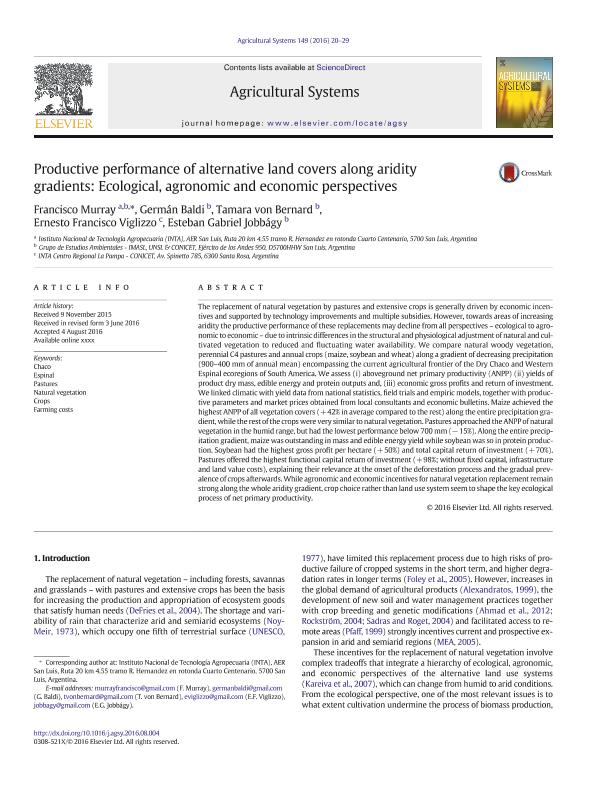Mostrar el registro sencillo del ítem
dc.contributor.author
Murray, Francisco
dc.contributor.author
Baldi, Germán

dc.contributor.author
von Bernard, Tamara
dc.contributor.author
Viglizzo, Ernesto Francisco

dc.contributor.author
Jobbagy Gampel, Esteban Gabriel

dc.date.available
2018-08-15T19:23:57Z
dc.date.issued
2016-11
dc.identifier.citation
Murray, Francisco; Baldi, Germán; von Bernard, Tamara; Viglizzo, Ernesto Francisco; Jobbagy Gampel, Esteban Gabriel; Productive performance of alternative land covers along aridity gradients: Ecological, agronomic and economic perspectives; Elsevier; Agricultural Systems; 149; 11-2016; 20-29
dc.identifier.issn
0308-521X
dc.identifier.uri
http://hdl.handle.net/11336/55715
dc.description.abstract
The replacement of natural vegetation by pastures and extensive crops is generally driven by economic incentives and supported by technology improvements and multiple subsidies. However, towards areas of increasing aridity the productive performance of these replacements may decline from all perspectives – ecological to agronomic to economic – due to intrinsic differences in the structural and physiological adjustment of natural and cultivated vegetation to reduced and fluctuating water availability. We compare natural woody vegetation, perennial C4 pastures and annual crops (maize, soybean and wheat) along a gradient of decreasing precipitation (900–400 mm of annual mean) encompassing the current agricultural frontier of the Dry Chaco and Western Espinal ecoregions of South America. We assess (i) aboveground net primary productivity (ANPP) (ii) yields of product dry mass, edible energy and protein outputs and, (iii) economic gross profits and return of investment. We linked climatic with yield data from national statistics, field trials and empiric models, together with productive parameters and market prices obtained from local consultants and economic bulletins. Maize achieved the highest ANPP of all vegetation covers (+ 42% in average compared to the rest) along the entire precipitation gradient, while the rest of the crops were very similar to natural vegetation. Pastures approached the ANPP of natural vegetation in the humid range, but had the lowest performance below 700 mm (− 15%). Along the entire precipitation gradient, maize was outstanding in mass and edible energy yield while soybean was so in protein production. Soybean had the highest gross profit per hectare (+ 50%) and total capital return of investment (+ 70%). Pastures offered the highest functional capital return of investment (+ 98%; without fixed capital, infrastructure and land value costs), explaining their relevance at the onset of the deforestation process and the gradual prevalence of crops afterwards. While agronomic and economic incentives for natural vegetation replacement remain strong along the whole aridity gradient, crop choice rather than land use system seem to shape the key ecological process of net primary productivity.
dc.format
application/pdf
dc.language.iso
eng
dc.publisher
Elsevier

dc.rights
info:eu-repo/semantics/openAccess
dc.rights.uri
https://creativecommons.org/licenses/by-nc-sa/2.5/ar/
dc.subject
Chaco
dc.subject
Crops
dc.subject
Espinal
dc.subject
Farming Costs
dc.subject
Natural Vegetation
dc.subject
Pastures
dc.subject.classification
Meteorología y Ciencias Atmosféricas

dc.subject.classification
Ciencias de la Tierra y relacionadas con el Medio Ambiente

dc.subject.classification
CIENCIAS NATURALES Y EXACTAS

dc.title
Productive performance of alternative land covers along aridity gradients: Ecological, agronomic and economic perspectives
dc.type
info:eu-repo/semantics/article
dc.type
info:ar-repo/semantics/artículo
dc.type
info:eu-repo/semantics/publishedVersion
dc.date.updated
2018-08-15T14:22:02Z
dc.journal.volume
149
dc.journal.pagination
20-29
dc.journal.pais
Países Bajos

dc.journal.ciudad
Amsterdam
dc.description.fil
Fil: Murray, Francisco. Consejo Nacional de Investigaciones Científicas y Técnicas. Centro Científico Tecnológico Conicet - San Luis. Instituto de Matemática Aplicada de San Luis "Prof. Ezio Marchi". Universidad Nacional de San Luis. Facultad de Ciencias Físico, Matemáticas y Naturales. Instituto de Matemática Aplicada de San Luis "Prof. Ezio Marchi"; Argentina. Instituto Nacional de Tecnología Agropecuaria. Centro Regional La Pampa-San Luis; Argentina
dc.description.fil
Fil: Baldi, Germán. Consejo Nacional de Investigaciones Científicas y Técnicas. Centro Científico Tecnológico Conicet - San Luis. Instituto de Matemática Aplicada de San Luis "Prof. Ezio Marchi". Universidad Nacional de San Luis. Facultad de Ciencias Físico, Matemáticas y Naturales. Instituto de Matemática Aplicada de San Luis "Prof. Ezio Marchi"; Argentina
dc.description.fil
Fil: von Bernard, Tamara. Consejo Nacional de Investigaciones Científicas y Técnicas. Centro Científico Tecnológico Conicet - San Luis. Instituto de Matemática Aplicada de San Luis "Prof. Ezio Marchi". Universidad Nacional de San Luis. Facultad de Ciencias Físico, Matemáticas y Naturales. Instituto de Matemática Aplicada de San Luis "Prof. Ezio Marchi"; Argentina
dc.description.fil
Fil: Viglizzo, Ernesto Francisco. Consejo Nacional de Investigaciones Científicas y Técnicas; Argentina. Instituto Nacional de Tecnología Industrial. Centro Regional La Pampa; Argentina
dc.description.fil
Fil: Jobbagy Gampel, Esteban Gabriel. Consejo Nacional de Investigaciones Científicas y Técnicas. Centro Científico Tecnológico Conicet - San Luis. Instituto de Matemática Aplicada de San Luis "Prof. Ezio Marchi". Universidad Nacional de San Luis. Facultad de Ciencias Físico, Matemáticas y Naturales. Instituto de Matemática Aplicada de San Luis "Prof. Ezio Marchi"; Argentina
dc.journal.title
Agricultural Systems

dc.relation.alternativeid
info:eu-repo/semantics/altIdentifier/doi/http://dx.doi.org/10.1016/j.agsy.2016.08.004
dc.relation.alternativeid
info:eu-repo/semantics/altIdentifier/url/https://www.sciencedirect.com/science/article/pii/S0308521X16303833
Archivos asociados
